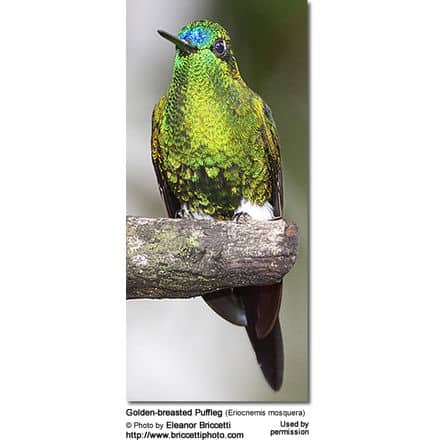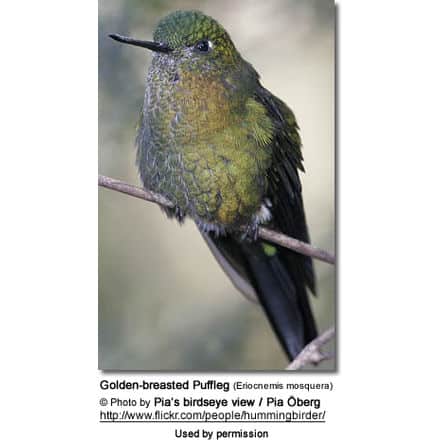Golden-breasted Pufflegs
The Golden-breasted Pufflegs (Eriocnemis mosquera) are South American hummingbirds.
Distribution
The Golden-breasted Pufflegs occur naturally in the southwestern and central Andes of Colombia (south from Caldas) to northwestern Ecuador.
Some sightings of them in the east Andes of Colombia have turned out to be wrong.
They inhabit subtropical or tropical moist montane forests.
Other (Globall) Names
Spanish: Calzadito de Mosquera, Calzoncitos Áureo, Colibrí Pantalón Oliva … Italian: Colibrì zampepiumose pettodorato, Fiocchetto pettodorato … French: Érione à poitrine d’or … Czech: Kolibrík zlatoprsý, kolib?ík zlatoprsý … Danish: Gyldenbrystet Kvastben … German: Goldbrust-Höschenkolibri, Goldbrust-Schneehöschen … Finnish: Kultasukkakolibri … Japanese: kimmunewataashihachidori, kinmunewataashihachidori … Dutch: Goudbuikpluimbroekje, Goudbuik-pluimbroekje … Norwegian: Gullbrystdunfot … Polish: puchatek zlotawy, puchatek z?otawy … Swedish: Gyllenbröstad tofsbena
Hummingbird Resources
- Hummingbird Information
- Hummingbird Amazing Facts
- Attracting Hummingbirds to Your Garden
- Hummingbird Species
- Feeding Hummingbirds
Description
Golden-breasted Pufflegs are just over 10 cm or 4 inches long (including tail and beak).
The upper plumage is bronze-green turning pure green on the lower back and luminous on the upper tail feathers. The throat and chest are a glossy golden-bronze.
The sides and abdomen are shiny bronzy green, and the wings are purplish-brown. They have black feet and a forked tail.
This species was named for the snow-white dense feathering around the legs known as “leg puffs” (which are not always visible). These leg puffs are unique to the pufflegs and have been described as resembling “woolly panties” or “little cotton balls” above the legs.
Populations in the northern part of central Cordillera of Colombia have a slightly greener plumage and have a longer bill.
Nesting / Breeding
Hummingbirds are solitary in all aspects of life other than breeding; and the male’s only involvement in the reproductive process is the actual mating with the female. They neither live nor migrate in flocks; and there is no pair bond for this species. Males court females by flying in a u-shaped pattern in front of them. He will separate from the female immediately after copulation. One male may mate with several females. In all likelihood, the female will also mate with several males. The males do not participate in choosing the nest location, building the nest or raising the chicks.
The female Golden-breasted Puffleg is responsible for building the cup-shaped nest out of plant fibers woven together and green moss on the outside for camouflage in a protected location in a shrub, bush or tree. She lines the nest with soft plant fibers, animal hair and feather down, and strengthens the structure with spider webbing and other sticky material, giving it an elastic quality to allow it to stretch to double its size as the chicks grow and need more room. The nest is typically found on a low, thin horizontal branch.
The average clutch consists of two white eggs, which she incubates alone, while the male defends his territory and the flowers he feeds on. The young are born blind, immobile and without any down.
The female alone protects and feeds the chicks with regurgitated food (mostly partially-digested insects since nectar is an insufficient source of protein for the growing chicks). The female pushes the food down the chicks’ throats with her long bill directly into their stomachs.
As is the case with other hummingbird species, the chicks are brooded only the first week or two, and left alone even on cooler nights after about 12 days – probably due to the small nest size. The chicks leave the nest when they are about 20 days old.
Diet / Feeding
The Golden-breasted Pufflegs primarily feed on nectar taken from a variety of brightly colored, scented small flowers of trees, herbs, shrubs and epiphytes. They favor flowers with the highest sugar content (often red-colored and tubular-shaped) and seek out, and aggressively protect, those areas containing flowers with high energy nectar.They use their long, extendible, straw-like tongues to retrieve the nectar while hovering with their tails cocked upward as they are licking at the nectar up to 13 times per second. Sometimes they may be seen hanging on the flower while feeding.
Many native and cultivated plants on whose flowers these birds feed heavily rely on them for pollination. The mostly tubular-shaped flowers actually exclude most bees and butterflies from feeding on them and, subsequently, from pollinating the plants.
They may also visit local hummingbird feeders for some sugar water, or drink out of bird baths or water fountains where they will either hover and sip water as it runs over the edge; or they will perch on the edge and drink – like all the other birds; however, they only remain still for a short moment.
They also take some small spiders and insects – important sources of protein particularly needed during the breeding season to ensure the proper development of their young. Insects are often caught in flight (hawking); snatched off leaves or branches, or are taken from spider webs. A nesting female can capture up to 2,000 insects a day.
Males establish feeding territories, where they aggressively chase away other males as well as large insects – such as bumblebees and hawk moths – that want to feed in their territory. They use aerial flights and intimidating displays to defend their territories.







